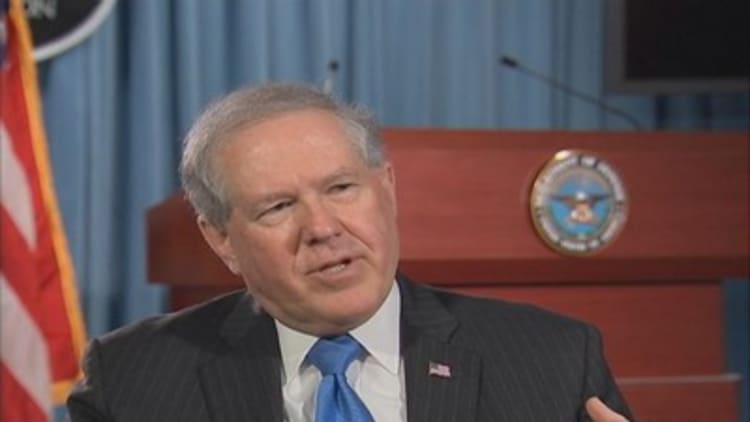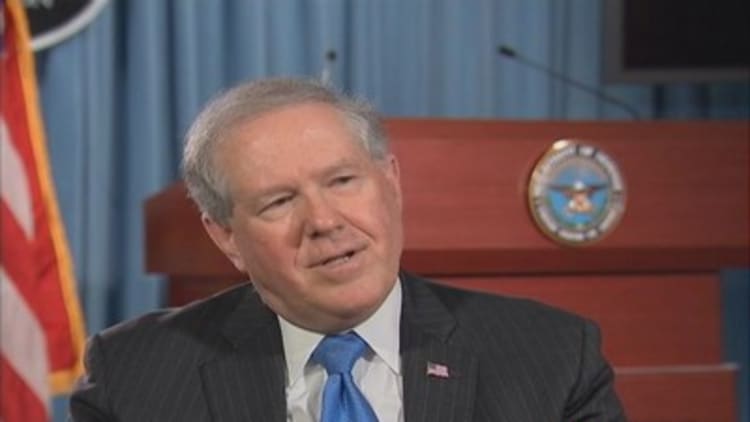Frank Kendall's first stint at the Pentagon was in the 1980s during the Cold War. He arrived to work on the Strategic Defense Initiative, better known as the "Star Wars Program."

As we look at where the defense industry will be in 25 years, let's first look back. A quarter century ago, in 1989, America was debuting a new age of defense technology, with the stealth fighter and bomber. Surveillance capabilities improved dramatically, leading, Kendall said, to reduced casualties in the coming conflicts.
"The predictions of casualties going into the first Gulf War were in the tens of thousands," Kendall said last week inside the Pentagon. "We only had a few hundred."
Read MoreUS should supply weapons to Ukraine: Advisor
Kendall returned to the Pentagon a few years ago and is now Under Secretary of Defense for Acquisitions, Technology and Logistics. It's his job to write the checks for programs that will shape our defense forces for the next quarter century—to defense giants like Lockheed Martin, Northrop Grumman, General Dynamics, Boeing and others.
In a rare interview, he sat down and discussed key areas of concern, and key weapons systems that are evolving.
Outer space
"Space is becoming a much more contested environment," Kendall said. "It's kind of crowded."
He said he sees the need to fund programs that can protect American satellites. "There is, from the intelligence I've seen, an attempt at least by some countries to build systems that would allow them to dominate in space, to take out our assets, which are very vulnerable," he said.
Read More
Kendall said possible solutions include taking the multiple functions placed on a few very expensive satellites and shifting them to a number of smaller, less expensive satellites. "It makes it harder to attack all of them," he said.
Another possible solution is to have backups ready to launch in case satellites are destroyed.
"It's all expensive," he said. "Any of those is expensive, which is why we haven't done them so far."
Drones and robots
No program has progressed more rapidly over the last quarter century than unmanned systems, whether in the air or on the ground, and these life-saving, cost-saving programs will only expand.
"We are looking at provisions for operating unmanned for the new bomber," he said. "The Navy is starting a new carrier-based unmanned system which will have some combat capability."
Kendall paused when asked just how autonomous unmanned systems should be, how much freedom might be programmed in to allow them to make their own decisions. "It's hard for me to predict how far we'll get with that technology over the next 10 to 20 years," he said.
He does believe, however, that more autonomy will come.
Read MoreHouse rejects Pentagon attempts to cut pay, weapons costs
"Give them aids first, things that help them make better decisions," he said, "and then moving more in the direction of okaying decisions made by machines."
As for allowing machines to make their own decisions to kill, "War is a human endeavor, and the decision to employ violence against human beings and deliver 'lethal effects' as we call it sometimes, is really a decision that I'm not comfortable taking out of the hands of human beings any time soon."
Kendall said he's worried, though, that others might not feel the same: "I think the U.S. has been very good about constraining itself. You can't count on the fact others will do that."
Cyberwarfare

The Defense Department is reportedly tripling its cyber security staff, and much of what the country's defense force will look like in 25 years will be focused on protecting computer systems vital to security, banking and infrastructure.
"People have talked occasionally about a 'Cyber Pearl Harbor.' I'm not sure that's a valid concept, but it's certainly a possibility," Kendall said.
Read MoreBatten down the hatches, there's trouble in the China sea
What about developing cyber as an offensive weapon of war?
"It's hard to resist a weapon which you think would be effective and help protect the national interest. On the other hand, we do have some rules of the road, if you will, in terms of the law of weapons...chemical weapons being an example of that," he said.
The F-35
The F-35 Joint Strike Fighter from Lockheed Martin will be the most expensive program in Pentagon history, perhaps costing taxpayers an average of $1 billion a month for the next quarter century. At the same time, the super stealthy fighter jet isn't ready for prime time yet. Kendall said he believes, however, that the F-35 will become the backbone of our nation's air defenses.
"People have asked me if it's too big to fail," he said. "I think we are past the point (at) which I think that's anything we would consider. The airplane is working its way through the test program. I have some concerns with regard to software and reliability and all the things that we still need to do engineering work on. But in terms of our ability to field that fighter, and its ability to do what we ask of it, I think we're going to get there," he said. "I don't think there's any question about it at this point."
Future priorities
Twenty-five years ago, in 1989, the Berlin Wall fell, and the Cold War ended. Now it may be heating up again. Who knows what the world will look like 25 years from now, in 2039? But decisions have to be made today. The development and production of weapons systems takes years.
Kendall said that as the Pentagon's focus moves back to the Pacific, it will mean a budget biased in favor of the Navy and Air Force, at the expense of the Army. (Some have argued that the Marine Corps is no longer needed, but Kendall disagrees: "There will definitely be a Marine Corps.")
There is a also a huge push by the military, especially the Navy, to purchase common software systems that will put all pieces of equipment—ships, planes, unmanned systems, radar, satellites—on one platform for better communication and more efficient operations. It might even save money.
Read MoreOdessa: The city that may be Ukraine's line in the sand
Perhaps Frank Kendall's top priority, however, is preserving America's edge.
"My biggest concern right now is the overall erosion of our technology superiority," he said. Defense research budgets are being cut, along with everything else. Beyond the F-35, Kendall said, there is very little that's new in the pipeline, and much of what America's military force will look like in 25 years is going to be upgraded versions of what it has now.
"I'm worried about what I'm seeing others doing. The two countries I watch most closely are China and Russia, not just because they're potential adversaries, but because they tend to sell to people who might be potential adversaries," he said. "We can't be complacent. Our technological superiority that we've relied upon for decades is not assured at all."





